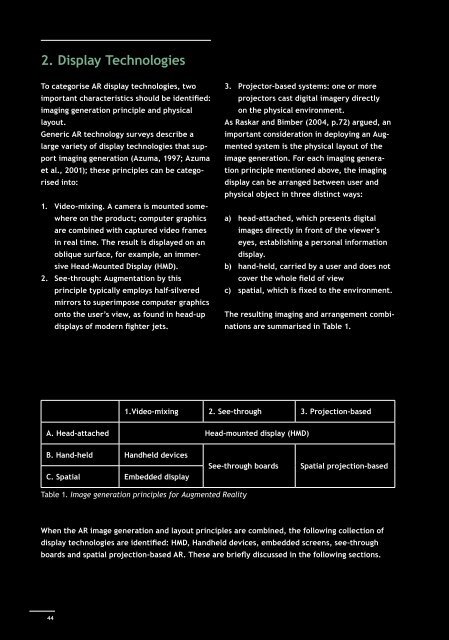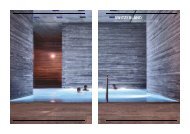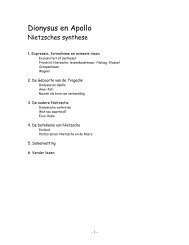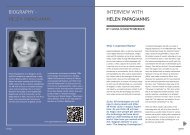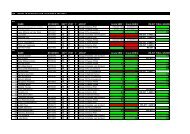download LR pdf - Kabk
download LR pdf - Kabk
download LR pdf - Kabk
Create successful ePaper yourself
Turn your PDF publications into a flip-book with our unique Google optimized e-Paper software.
2. Display Technologies2.1 Head-mounted displayTo categorise AR display technologies, twoimportant characteristics should be identified:imaging generation principle and physicallayout.Generic AR technology surveys describe alarge variety of display technologies that supportimaging generation (Azuma, 1997; Azumaet al., 2001); these principles can be categorisedinto:3. Projector-based systems: one or moreprojectors cast digital imagery directlyon the physical environment.As Raskar and Bimber (2004, p.72) argued, animportant consideration in deploying an Augmentedsystem is the physical layout of theimage generation. For each imaging generationprinciple mentioned above, the imagingdisplay can be arranged between user andphysical object in three distinct ways:1. Video-mixing. A camera is mounted somewhereon the product; computer graphicsare combined with captured video framesin real time. The result is displayed on anoblique surface, for example, an immersiveHead-Mounted Display (HMD).2. See-through: Augmentation by thisprinciple typically employs half-silvereda) head-attached, which presents digitalimages directly in front of the viewer’seyes, establishing a personal informationdisplay.b) hand-held, carried by a user and does notcover the whole field of viewc) spatial, which is fixed to the environment.mirrors to superimpose computer graphicsonto the user’s view, as found in head-updisplays of modern fighter jets.The resulting imaging and arrangement combinationsare summarised in Table 1.1.Video-mixing 2. See-through 3. Projection-basedA. Head-attached Head-mounted display (HMD)B. Hand-held Handheld devicesSee-through boards Spatial projection-basedC. Spatial Embedded displayTable 1. Image generation principles for Augmented RealityHead-attached systems refer to HMD solutions,which can employ either of the three imagegeneration technologies. Even the first headmounteddisplays developed by virtue of theVirtual Reality already considered a see-throughsystem with half-silvered mirrors to mergevirtual line drawings with the physical environment(Sutherland, 1967). Since then, the varietyof head-attached imaging systems has beenexpanded and encompasses all three principlesfor AR: video-mixing, see-through and directprojection on the physical world (Azuma et al.,2001). A benefit of this approach is its handsfreenature. Secondly, it offers personalisedcontent, enabling each user to have a privateview of the scene with customised and sensitivedata that das not have to be shared. Formost applications, HMDs have been consideredinadequate, both in the case of see-through andvideo-mixing imaging. According to Klinker et al.(2002), HMDs introduce a large barrier betweenthe user and the object and their resolution isinsufficient for IAP — typically 800 × 600 pixelsfor the complete field of view (rendering theuser “legally blind”by American standards).Similar reasoning was found in Bochenek et al.(2001), in which both the objective and subjectiveassessment of HMDs were less than those ofhand-held or spatial imaging devices. However,new developments (specifically high-resolutionOLED displays) show promising new devices, specificallyfor the professional market (Carl Zeiss)and enterntainment (Sony), see figure right.Figure 1. Recent Head Mounted Displays (above: KABK theHague and under: Carl Zeiss).When the AR image generation and layout principles are combined, the following collection ofdisplay technologies are identified: HMD, Handheld devices, embedded screens, see-throughboards and spatial projection-based AR. These are briefly discussed in the following sections.2.2 Handheld displayHand-held video-mixing solutions are based onsmartphones, PDAs or other mobile devicesequipped with a screen and camera. With theadvent of powerful mobile electronics, handheldAugmented Reality technologies are emerging.By employing built-in cameras on smartphonesor PDAs, video mixing is enabled while concurrentuse is being supported by communication4445


